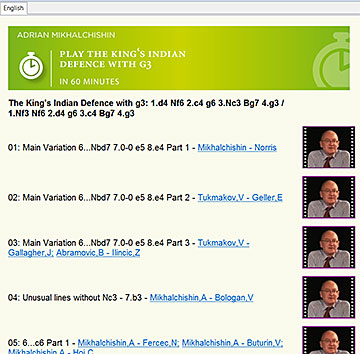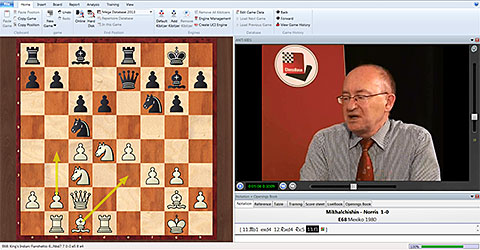


 There are a number of reasons to really like ChessBase’s 60-minute series, one is the price, another is the speed of consumption from payment to actual viewing, and the last is obviously the length. There are times when ‘more’ is not better or desirable, and that is precisely where the series fits in.
There are a number of reasons to really like ChessBase’s 60-minute series, one is the price, another is the speed of consumption from payment to actual viewing, and the last is obviously the length. There are times when ‘more’ is not better or desirable, and that is precisely where the series fits in.
When the first iterations came out, proposing to give a speedy, yet comprehensive introduction to a variety of opening lines, I was somewhat doubtful: could they really deliver without being overly superficial, or trying to cram too much in such a short time? I waited for one that covered a line I was interested in playing, and out came veteran trainer GM Adrian Mikhalchishin with his spin on the King’s Indian with g3.
I was rather amazed to see the table of contents list no fewer than twelve videos, each following the typical presentation of far larger products in the ChessBase catalogue.
The King's Indian Defence with g3: 1.d4 Nf6 2.c4 g6 3.Nc3 Bg7 4.g3 / 1.Nf3 Nf6 2.d4 g6 3.c4 Bg7 4.g3
01: Main Variation 6...Nbd7 7.0-0 e5 8.e4 Part 1 - Mikhalchishin - Norris
02: Main Variation 6...Nbd7 7.0-0 e5 8.e4 Part 2 - Tukmakov,V - Geller,E
03: Main Variation 6...Nbd7 7.0-0 e5 8.e4 Part 3 - Tukmakov,V - Gallagher,J; Abramovic,B - Ilincic,Z
04: Unusual lines without Nc3 - 7.b3 - Mikhalchishin,A - Bologan,V
05: 6...c6 Part 1 - Mikhalchishin,A - Fercec,N; Mikhalchishin,A - Buturin,V; Mikhalchishin,A - Hoi,C
06: 6...c6 Part 2 - Pigusov,E - Kozul,Z
07: 6...c6 Part 3 - Mikhalchishin,A - Ragger,M
08: Panno Variation 6...Nc6 Part 1 - Karpov,A - Polgar,J; Akopian,V - Kotsur,P
09: Panno Variation 6...Nc6 Part 2 - Mikhalchishin,A - Westerinen,H; Mikhalchishin,A - Velimirovic,D
10: Panno Variation 6...Nc6 and 7...a6 - Krasenkow,M - Socko,B; Mihalcisin - Ufuk; Mikhalchishin,A - Gleizerov,E
11: 6...c5 7.0-0 without d5 by White - Mikhalchishin,A - Tringov,G; Epishin,V - Spraggett,K; Grigorian,K - Kasparov,G
12: Unusual Lines - Huebner,R - Sokolov,I; Karpov,A - Timman,J

As you can see, the list looks quite complete, yet the question still remained: this is a 60-minute video, right?
In the first video, Mikhalchishin explains that when facing aggressive lines such as the King’s Indian or the Gruenfeld, a player has three approaches. The first is to take the bull by the horns and try to outprepare the opponent in the main lines. While one of the most efficient, it also requires a huge amount of work if the opponent is well-prepared. The second is to play one of the space-grabbing lines such as the Saemisch, though also very theoretical, and finally there are the less confrontational lines involving the fianchetto of the bishop. There are a few advantages in the last approach: White imposes the type of game the aggressive black payer had hoped to avoid. White also has a variety of very flexible plans, based more on guiding principles than make-or-break opening moves where any misstep can be fatal.

Adrian Mikhalchishin gives a master class on the King's Indian with g3
True to the spirit of this explanation, the videos all contain important games that illustrate the principal ideas and plans of the main lines, and do not push the theory too hard, just enough to help the student not go astray.
The first game is one of the grandmaster himself, but it soon becomes clear this is a line he has a huge amount of experience in. He pulls out a number of games from his own practice, to games that helps illustrate White’s play. At all times he tries to convey the viewer confidence in the opening he is proposing to play, and he certainly does that, showing how this was even used to help prepare Susan Polgar in her World Championship match.
Obviously with so much information, a second viewing will undoubtedly be desirable, however the fact remains that the viewer has a very rich presentation in the opening by a player with decades of experience behind him.
All in all, I found Adrian Mikhalchisin’s choice of material and approach to be extremely efficient and anyone buying it can rest assured they are getting more than their money’s worth. Highly recommended.
Click here to purchase The King's Indian Defence with g3 in the ChessBase Shop.
A sample of Adrian Mikhalchishin - Play the King's Indian Defence with g3 in 60 Minutes